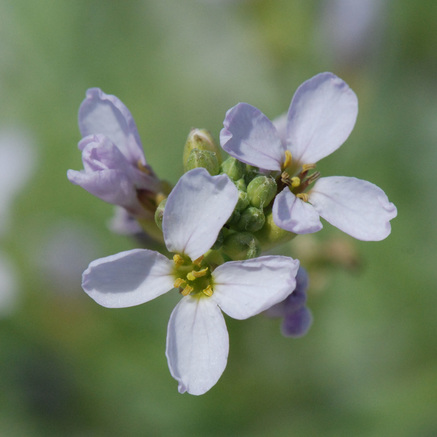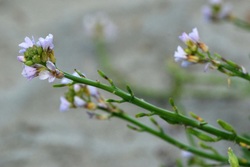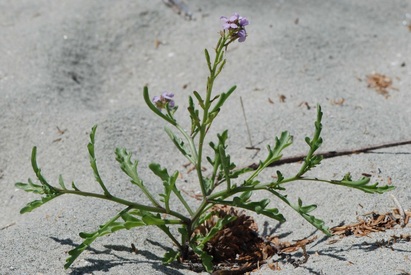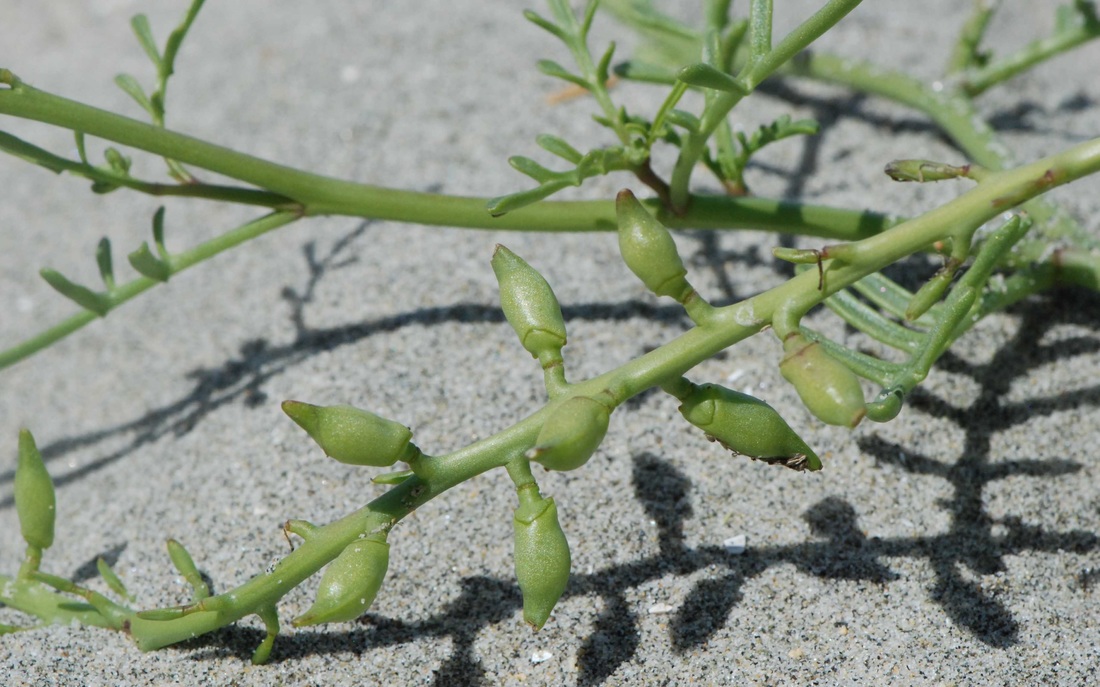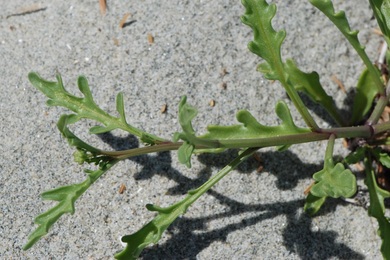European searocket • Cakile maritima
Identification
European searocket is a fleshy taprooted annual with 15-45 cm long sprawling or upright stems. Its stalked basal leaves are usually deeply divided into pinnate lobes, while its unstalked stem leaves may be less divided. Clusters (racemes) of small purple to white flowers occur along the ends of flowering stems. This species bears pod-like fruits (siliques) 1.5-3 cm long, with bases that expand out into 'wings.'
Habitat & Range
European searocket grows on sandy beaches. It is an introduced species from Europe found along some coastlines in the United States and British Columbia. In BC it has been recorded on Haida Gwaii, sporadic locations along the west coast of Vancouver Island, and beaches in the Tsawwassen area.
Similar Species
American searocket (Cakile edentula) has less divided leaves, smaller flowers, and rounder fruits without flared bases. See this west coast Cakile ID guide for further information on differentiating these species.
Intriguing Info
The seeds of both searocket species float, making dispersal via water simple and effective propagation mechanism. European searocket appears to be replacing American searocket along the west coasts of both North America and Australia. See this species factsheet for more information. The distribution of both searockets, and the apparent displacement of one by the other, is the subject of the West Coast Cakile Project.
European searocket is a fleshy taprooted annual with 15-45 cm long sprawling or upright stems. Its stalked basal leaves are usually deeply divided into pinnate lobes, while its unstalked stem leaves may be less divided. Clusters (racemes) of small purple to white flowers occur along the ends of flowering stems. This species bears pod-like fruits (siliques) 1.5-3 cm long, with bases that expand out into 'wings.'
Habitat & Range
European searocket grows on sandy beaches. It is an introduced species from Europe found along some coastlines in the United States and British Columbia. In BC it has been recorded on Haida Gwaii, sporadic locations along the west coast of Vancouver Island, and beaches in the Tsawwassen area.
Similar Species
American searocket (Cakile edentula) has less divided leaves, smaller flowers, and rounder fruits without flared bases. See this west coast Cakile ID guide for further information on differentiating these species.
Intriguing Info
The seeds of both searocket species float, making dispersal via water simple and effective propagation mechanism. European searocket appears to be replacing American searocket along the west coasts of both North America and Australia. See this species factsheet for more information. The distribution of both searockets, and the apparent displacement of one by the other, is the subject of the West Coast Cakile Project.
References
Cakile maritima Scop. In Klinkenberg, Brian. (Ed.). E-Flora BC: Electronic Atlas of the Plants of British Columbia. Lab for Advanced Spatial Analysis, Department of Geography, University of British Columbia, Vancouver. Accessed 11/08/2015.
Pojar, J. and MacKinnon, A. (1994). Plants of Coastal British Columbia. Vancouver, BC: Lone Pine Publishing. P. 153.
Authors and editors of page
Kelly Fretwell and Brian Starzomski (2015).
Cakile maritima Scop. In Klinkenberg, Brian. (Ed.). E-Flora BC: Electronic Atlas of the Plants of British Columbia. Lab for Advanced Spatial Analysis, Department of Geography, University of British Columbia, Vancouver. Accessed 11/08/2015.
Pojar, J. and MacKinnon, A. (1994). Plants of Coastal British Columbia. Vancouver, BC: Lone Pine Publishing. P. 153.
Authors and editors of page
Kelly Fretwell and Brian Starzomski (2015).
